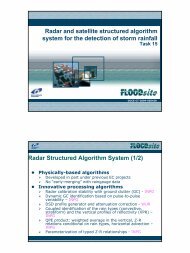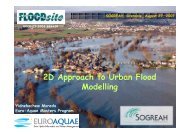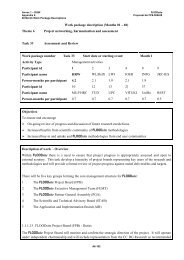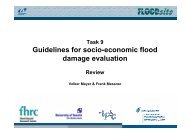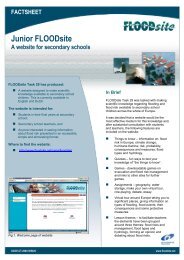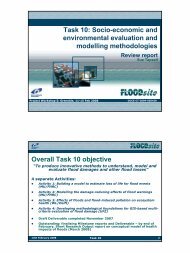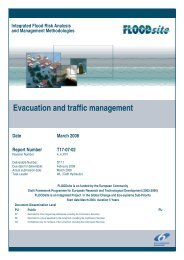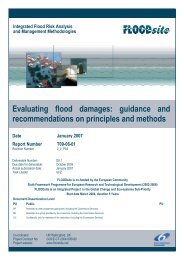Language of Risk - FLOODsite
Language of Risk - FLOODsite
Language of Risk - FLOODsite
Create successful ePaper yourself
Turn your PDF publications into a flip-book with our unique Google optimized e-Paper software.
<strong>FLOODsite</strong> <strong>Language</strong> <strong>of</strong> <strong>Risk</strong> 2 nd Ed.<br />
Contract No:GOCE-CT-2004-505420<br />
3. Concepts<br />
3.1 What is risk?<br />
Today, the term “risk’” has a range <strong>of</strong> meanings and multiple dimensions relating to safety, economic,<br />
environmental and social issues. These different meanings <strong>of</strong>ten reflect the needs <strong>of</strong> particular<br />
decision-makers and as a result there is no unique specific definition for risk and any attempt to<br />
develop one would inevitably satisfy only a proportion <strong>of</strong> risk managers. Indeed this very adaptability<br />
<strong>of</strong> the concept <strong>of</strong> risk is one <strong>of</strong> its strengths. A difficulty with the terminology <strong>of</strong> “risk” is that it has<br />
been developed across a wide range <strong>of</strong> disciplines and activities, there is therefore potential for<br />
misunderstanding in technical terminology associated with risk assessment, since technical<br />
distinctions are made between words which in common usage are normally treated as synonyms.<br />
Most important is the distinction that is drawn between the words “hazard” and “risk”.<br />
Consequence<br />
Figure 3.1 Source – Pathway – Receptor-Consequence conceptual model<br />
To understand the linkage between hazard and<br />
risk it is useful to consider the commonly<br />
adopted Source-Pathway-Receptor-<br />
Consequence (S-P-R-C) model (See Figure<br />
3.1).<br />
This is, essentially, a simple conceptual model<br />
for representing systems and processes that<br />
lead to a particular consequence. For a risk to<br />
arise there must be hazard that consists <strong>of</strong> a<br />
'source' or initiator event (i.e. high rainfall); a<br />
'receptor' (e.g. flood plain properties); and a<br />
pathway between the source and the receptor<br />
(i.e. flood routes including defences, overland<br />
flow or landslide).<br />
A hazard does not automatically lead to a<br />
harmful outcome, but identification <strong>of</strong> a<br />
hazard does mean that there is a possibility <strong>of</strong><br />
harm occurring, with the actual harm<br />
depending upon the exposure to the hazard<br />
and the characteristics <strong>of</strong> the receptor.<br />
Thus, to evaluate the risk, consideration needs to be made <strong>of</strong> a number <strong>of</strong> components:<br />
• the nature and probability <strong>of</strong> the hazard (p)<br />
• the degree <strong>of</strong> exposure <strong>of</strong> the Receptors (numbers <strong>of</strong> people and property) to the hazard (e).<br />
• the susceptibility <strong>of</strong> the Receptors to the hazard (s)<br />
• the value <strong>of</strong> the Receptors(v)<br />
Therefore:<br />
<strong>Risk</strong> = function (p, e, s, v)<br />
In this context vulnerability is a sub-function <strong>of</strong> risk. The term encompasses the characteristics <strong>of</strong> a<br />
system that describes its potential to be harmed. It can be expressed in terms <strong>of</strong> all functional<br />
relationships between expected damage and system characteristics (susceptibility, value <strong>of</strong> elements at<br />
risk), regarding the whole range <strong>of</strong> relevant flood hazards. Or, in functional form:<br />
Vulnerability = function (s, v)<br />
T32_04_01_ <strong>FLOODsite</strong>_<strong>Language</strong>_<strong>of</strong>_<strong>Risk</strong>_D32_2_v5_2_P1 30 April 2009<br />
4



